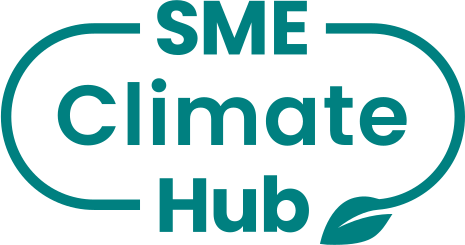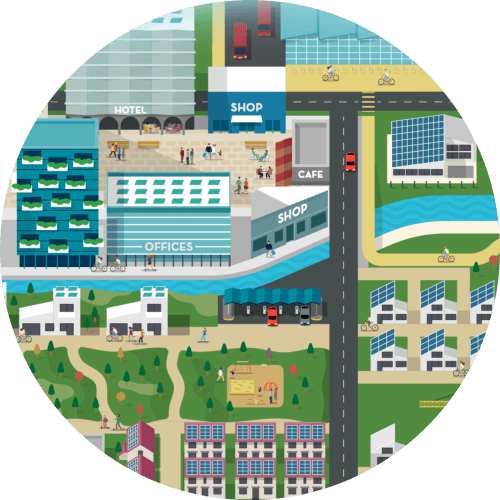See the steps your company can take towards a more sustainable future through our open resources.
Real Earth Solutions's Climate Report
Introduction *
Commitment And Targets *
Own emissions *
Value chain emissions *
(optional)Actions and plans to reduce emissions *
Climate Solutions *
(optional)Management and strategy *
(optional)Results, challenges and outlook *
Introduction *
reporting year
*2023
number of employees in the reporting year
*1
Commitment And Targets *
net zero target year
*2025
Base year
*2020
comment on your net zero targets
*As a service business, with a home office, the emissions are already low, so a date of 2025 is achievable.
near-term scope 1 target
*50
target year
*2024
near-term scope 2 target
*100
target year
*2023
near-term scope 3 target
*50
target year
*2024
comment on your near-term targets
*Already 100% renewable energy to power the business. Travel makes up most of the emissions, from a petrol fueled vehicle, and any airline travel.
Own emissions *
scope 1 emissions
scope 1 emissions (metric tons co2e)
*2.78
own facilities
*N/A
own vehicles
*2.78
metric tons CO2eown processes
*N/A
scope 2 emissions
scope 2 emissions (metric tons co2e)
*0.01
total energy consumption (kwh)
*2555
renewable energy
*100
purchased electricity
*Not measured
Renewable electricity (%)
100
purchased steam
*N/A
Renewable electricity (%)
-
purchased heating
*N/A
Renewable electricity (%)
-
purchased cooling
*N/A
Renewable electricity (%)
-
Comment on your energy consumption
*Energy is 100% purchased renewable energy, including heating, cooling, and hot water. Zero gas.
Value chain emissions (optional) *
scope 3 emissions
scope 3 emissions (metric tons co2e)
*1.76
supply chain related - upstream emissions
purchased goods and services
*1.62
metric tons CO2ecapital goods
*N/A
fuel and energy related activities
*N/A
transportation and distribution (upstream)
*N/A
waste in operations
*N/A
business travel
*.136
metric tons CO2eemployee commuting
*N/A
leased assets (upstream)
*N/A
customer related - downstream emissions
transportation and distribution (downstream)
*N/A
processing of sold products
*N/A
use of sold products
*N/A
end-of-life treatment of products
*N/A
leased assets (downstream)
*N/A
franchises
*N/A
investments
*N/A
describe the calculation methodology and comment on accuracy:
*Used the normative calculator Due to personal circumstances, business activity has been low for this period.
Actions and plans to reduce emissions *
Scope 1 Actions
own facilities
Yes
Plan to improve efficiency of building with increased insulation.
own vehicles
Yes
Plan to replace existing petrol vehicle with hybrid or electric vehicle.
own processes
N/A
Minimal emissions from service-based business. Already purchase second hand whenever possible.
scope 2 actions
purchased electricity
Yes
100% renewable energy is already purchased. Zero gas. Plan to install solar panels on the building to generate electricity on site.
purchased steam
N/A
-
purchased heating
N/A
Included in electricity use via reverse-cycle air conditioner (heat pump).
purchased cooling
N/A
Included in electricity use via reverse-cycle air conditioner (heat pump).
scope 3 actions
supply chain related (upstream)
purchased good and services
*Yes
Purchase second hand whenever possible. Purchase from businesses that are carbon neutral certified (eg internet and phone) whenever possible.
capital goods
*Yes
Puchase second hand whenever possible. Purchase from companies with carbon neutral/ sustainability related certifications (eg TCO certified for IT equipment)
fuel and energy related activities
*N/A
Vehicle use included in Scope 1 business travel
transportation and distribution (upstream)
*N/A
-
waste in operation
*N/A
-
business travel
*Yes
Car to be changed to hybrid/electric to reduce emissions. Any necessary business travel is offset via Greening Australia.
employee commuting
*N/A
-
upstream leased assets
*N/A
-
customer related (downstream)
transportation and distribution (downstream)
*N/A
-
processing of sold products
*N/A
-
use of sold products
*N/A
-
end-of-life treatment of products
*N/A
-
leased assets (downstream)
*N/A
-
franchises
*N/A
-
investments
*N/A
-
i have asked my suppliers to halve emissions before 2030 and join the un-backed race to zero campaign
*Yes
percentage (%) of suppliers asked
*50
percentage (%) of suppliers committed
*-
i have communicated my commitment and actions to my business customers and asked them to join the un race to zero
*Yes
percentage (%) of business customers asked
*100
Percentage (%) of business customers committed
*-
Climate Solutions (optional) *
What percentage of your total revenue comes from sales of climate solutions?
*100
Provide descriptions/names of your climate solutions:
*Provide consultancy and training to organisations and businesses to make and meet their sustainability goals, including emissions.
Methodology used to assess these as climate solutions:
*Audit process to identify material issues, set goals, facilitate planning to meet goals, then re-assess.
are you investing in climate and/or nature outside your value chain?
*No
Management and strategy (optional) *
Results, challenges and outlook *

Real Earth Solutions's Climate Report
Real Earth Solutions's Climate Report - 2023
Introduction *
reporting year
*2023
number of employees in the reporting year
*1
Commitment And Targets *
net zero target year
*2025
Base year
*2020
comment on your net zero targets
*As a service business, with a home office, the emissions are already low, so a date of 2025 is achievable.
near-term scope 1 target
*50
target year
*2024
near-term scope 2 target
*100
target year
*2023
near-term scope 3 target
*50
target year
*2024
comment on your near-term targets
*Already 100% renewable energy to power the business. Travel makes up most of the emissions, from a petrol fueled vehicle, and any airline travel.
Own emissions *
scope 1 emissions
scope 1 emissions (metric tons co2e)
*2.78
own facilities
*N/A
own vehicles
*2.78
metric tons CO2eown processes
*N/A
scope 2 emissions
scope 2 emissions (metric tons co2e)
*0.01
total energy consumption (kwh)
*2555
renewable energy
*100
purchased electricity
*Not measured
Renewable electricity (%)
100
purchased steam
*N/A
Renewable electricity (%)
-
purchased heating
*N/A
Renewable electricity (%)
-
purchased cooling
*N/A
Renewable electricity (%)
-
Comment on your energy consumption
*Energy is 100% purchased renewable energy, including heating, cooling, and hot water. Zero gas.
Value chain emissions (optional) *
scope 3 emissions
scope 3 emissions (metric tons co2e)
*1.76
supply chain related - upstream emissions
purchased goods and services
*1.62
metric tons CO2ecapital goods
*N/A
fuel and energy related activities
*N/A
transportation and distribution (upstream)
*N/A
waste in operations
*N/A
business travel
*.136
metric tons CO2eemployee commuting
*N/A
leased assets (upstream)
*N/A
customer related - downstream emissions
transportation and distribution (downstream)
*N/A
processing of sold products
*N/A
use of sold products
*N/A
end-of-life treatment of products
*N/A
leased assets (downstream)
*N/A
franchises
*N/A
investments
*N/A
describe the calculation methodology and comment on accuracy:
*Used the normative calculator Due to personal circumstances, business activity has been low for this period.
Actions and plans to reduce emissions *
Scope 1 Actions
own facilities
Yes
Plan to improve efficiency of building with increased insulation.
own vehicles
Yes
Plan to replace existing petrol vehicle with hybrid or electric vehicle.
own processes
N/A
Minimal emissions from service-based business. Already purchase second hand whenever possible.
scope 2 actions
purchased electricity
Yes
100% renewable energy is already purchased. Zero gas. Plan to install solar panels on the building to generate electricity on site.
purchased steam
N/A
-
purchased heating
N/A
Included in electricity use via reverse-cycle air conditioner (heat pump).
purchased cooling
N/A
Included in electricity use via reverse-cycle air conditioner (heat pump).
scope 3 actions
supply chain related (upstream)
purchased good and services
*Yes
Purchase second hand whenever possible. Purchase from businesses that are carbon neutral certified (eg internet and phone) whenever possible.
capital goods
*Yes
Puchase second hand whenever possible. Purchase from companies with carbon neutral/ sustainability related certifications (eg TCO certified for IT equipment)
fuel and energy related activities
*N/A
Vehicle use included in Scope 1 business travel
transportation and distribution (upstream)
*N/A
-
waste in operation
*N/A
-
business travel
*Yes
Car to be changed to hybrid/electric to reduce emissions. Any necessary business travel is offset via Greening Australia.
employee commuting
*N/A
-
upstream leased assets
*N/A
-
customer related (downstream)
transportation and distribution (downstream)
*N/A
-
processing of sold products
*N/A
-
use of sold products
*N/A
-
end-of-life treatment of products
*N/A
-
leased assets (downstream)
*N/A
-
franchises
*N/A
-
investments
*N/A
-
i have asked my suppliers to halve emissions before 2030 and join the un-backed race to zero campaign
*Yes
percentage (%) of suppliers asked
*50
percentage (%) of suppliers committed
*-
i have communicated my commitment and actions to my business customers and asked them to join the un race to zero
*Yes
percentage (%) of business customers asked
*100
Percentage (%) of business customers committed
*-
Climate Solutions (optional) *
What percentage of your total revenue comes from sales of climate solutions?
*100
Provide descriptions/names of your climate solutions:
*Provide consultancy and training to organisations and businesses to make and meet their sustainability goals, including emissions.
Methodology used to assess these as climate solutions:
*Audit process to identify material issues, set goals, facilitate planning to meet goals, then re-assess.
are you investing in climate and/or nature outside your value chain?
*No
Management and strategy (optional) *
Results, challenges and outlook *
Not sure how to start?
See the steps you can take and get help building a plan to cut your business emissions today.
¿No estás seguro de por dónde empezar?
Revisa los pasos que puedes dar y obtén ayuda para elaborar un plan para reducir las emisiones de tu empresa hoy mismo.
لست متأكداً كيف تبدأ؟
اطلع على الخطوات التي يمكنك اتخاذها واحصل على المساعدة في وضع خطة لخفض انبعاثات شركتك اليوم.
Vous ne savez pas par où commencer ?
Découvrez les mesures que vous pouvez prendre et obtenez de l’aide pour élaborer un plan pour réduire les émissions de votre entreprise dès aujourd’hui.
Ready to commit to lower emissions?
It’s easy to make the commitment. Just complete a form sharing your intent to reduce your emissions.
You’ll earn public recognition for taking the first step.
¿Listo para comprometerte a reducir tus emisiones?
Es fácil comprometerse. Solo tienes que completar un formulario compartiendo tu intención de reducir tus emisiones.
Ganarás reconocimiento público por tomar este primer paso.
هل أنت مستعد للالتزام بتقليل الانبعاثات؟
الالتزام سهل. ما عليك سوى تعبئة نموذج لمشاركة عزمك على تقليل انبعاثاتك.
سوف تحظى باعتراف عام باتخاذك الخطوة الأولى.
Prêt à vous engager pour réduire les émissions ?
S’engager est simple. Il suffit de remplir un formulaire indiquant votre intention de réduire vos émissions.
Vous gagnerez une reconnaissance publique pour avoir fait le premier pas.
Register now to use our tools
Register now to use our tools

Stay updated!
Sign up for our newsletter to stay updated with the latest climate developments.
Log in
Don't have an account? Create account to access our tools or make the SME Climate Commitment
Log in
Don't have an account? Create account to access our tools or make the SME Climate Commitment
Log in
Don't have an account? Create account to access our tools or make the SME Climate Commitment
Forgot password?
Please enter your email address. You will receive a link to create a new password via email.

 Go back
Go back

